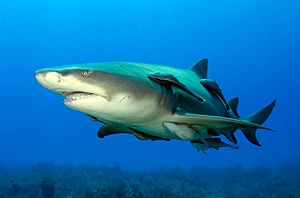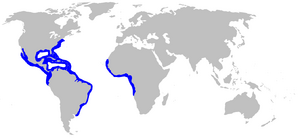Lemon shark facts for kids
Quick facts for kids Lemon shark |
|
|---|---|
 |
|
| A Lemon shark swimming with Remoras in the Bahamas | |
| Conservation status | |
| Scientific classification | |
| Kingdom: | |
| Phylum: | |
| Class: | |
| Order: | |
| Family: | |
| Genus: | |
| Species: |
N.brevirostris
|
 |
|
| Range of the Lemon shark | |
| Synonyms | |
|
Carcharias fronto Jordan & Gilbert, 1882 |
|
The Lemon shark (Negaprion brevirostris) is a cool shark. It gets its name from its yellowish back, which looks like a lemon! Its belly is usually off-white. These sharks are typically 8 to 10 feet long. They have long, sharp teeth that help them catch slippery fish. You can often find Lemon sharks along the southeast coast of the United States of America.
Contents
What Does a Lemon Shark Look Like?
The Lemon shark is named for its yellow color. It can also be brown or olive-grey. Its underside is usually white or a lighter yellow.
This shark has a strong body and a rounded snout. It has two dorsal fins (the fins on its back) that are about the same size. The first dorsal fin is behind its pectoral fins (side fins). The second dorsal fin is near its anal fin (bottom fin).
Lemon sharks have special teeth for catching prey. Their upper teeth are wide and triangular. Their lower teeth are narrow and also triangular. These teeth help them grab and hold onto fish.
Lemon sharks can grow up to 11 feet (3.4 meters) long. When they are born, baby sharks (called pups) are about 24 to 26 inches (60-65 cm) long.
Lemon Shark Life Cycle and Reproduction
Lemon sharks are viviparous. This means they give birth to live young, just like mammals. They do not lay eggs.
After being pregnant for 10 to 12 months, female sharks go into shallow areas. These areas are like nurseries for their babies. They give birth to litters of 4 to 17 pups in the spring and summer.
Baby Lemon sharks grow slowly. They stay in these safe nursery areas for a long time. This helps protect them from bigger predators. These nursery areas, often in mangroves, have lots of food. They also have low oxygen, but Lemon sharks have special blood that helps them get enough oxygen.
As they grow, young sharks start to travel farther. They might move from a few miles away to hundreds of miles away. Lemon sharks become adults when they are about 6 and a half years old. It is believed that Lemon sharks can live for up to 27 years.
How Lemon Sharks Behave
Lemon sharks are known for being very patient hunters. Their yellow color helps them blend in with their surroundings. They often swim close to the sandy bottom of the ocean. This makes it easy for them to hide from predators and sneak up on their prey.
Scientists think Lemon sharks have special eyes. This allows them to see clearly even in murky or dark water.
Because they blend in so well, people can sometimes accidentally get too close to a Lemon shark.
Lemon sharks do well in aquariums, which is not common for many shark species. They are also very social animals. They live in groups with a complex social order based on their size and gender.
Lemon sharks are generally calm and not aggressive towards people. They have been known to bite humans, but this usually happens if they feel threatened or provoked. They are not considered a major danger to people swimming in the ocean.
What Do Lemon Sharks Eat?
Lemon sharks mostly eat bony fish and crustaceans. Their diet includes fish like catfish, mullet, and jacks. They also eat crabs and crayfish. Sometimes, they will even eat sea birds or smaller sharks.
Lemon sharks will eat until they are full. How fast they digest their food depends on how much they ate.
Where Do Lemon Sharks Live?
Lemon sharks live in warm, tropical and subtropical waters. You can find them along the coastal areas of the Atlantic Ocean and Pacific Ocean.
They usually stay in shallow water, not going deeper than about 260 feet (80 meters). They are often found near coasts and islands. They like places like coral reefs, mangroves, bays, and sometimes even river mouths.
Lemon Sharks and Humans
Lemon sharks are not a big threat to humans. The International Shark Attack File has recorded only 10 unprovoked attacks by Lemon sharks. All of these happened in Florida and the Caribbean. No one has died from a Lemon shark attack. Even though they live in coastal waters where people swim, the low number of attacks shows they are not very dangerous.
People do fish for Lemon sharks. Commercial and recreational fishermen catch them in the U.S. Atlantic, Caribbean, and eastern Pacific Ocean. Their fins are very valuable and are sent to Asia for shark fin soup. Their skin can be used to make leather, and their meat is eaten by people.
Some scientists are worried that too many Lemon sharks are being caught. This could put their populations in danger, especially in the western North Atlantic and eastern Pacific Ocean.
Images for kids
-
A lemon shark with many remoras clinging to its body.
See also
 In Spanish: Tiburón galano o limón para niños
In Spanish: Tiburón galano o limón para niños





